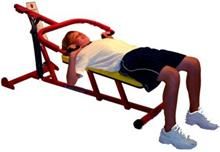Children's Health & Executive Club - TIME Magazine Article
Warming up with aerobics at the Children's Health & Executive Club in Chicago
 Victor Scotti wasn't feeling quite as agile as he wanted to be. So like more and more fitness-conscious Americans, he joined a gym, diligently showing up five times a week for a circuit-training regimen that included a cardio workout on the cross trainer, push-ups, crunches and weight training to target his biceps, triceps and quads. Now, Scotti says, "I've definitely gotten faster and a lot more limber." An added benefit is that it makes his mom happy too. Her opinion counts because Scotti is 12. The weight machines he pushes are mini-size, designed especially for the Children's Health & Executive Club (CHEC), a kids-only gym in Chicago. (The "executive" membership is for those who stay to do homework for two hours after the daily supervised two-hour physical routine.) "Schools have cut back on physical-education classes," says Sherry Drake, the owner of CHEC, which now has two other franchises. "Both the parents and the kids, some of whom are heavy and some of whom just want to move around, are looking for an outlet."Though CHEC, with its smaller-scale equipment and children-only policy, is not yet the norm, Scotti is just one of a rapidly growing group of teens and preteens who regularly hit the health club to lift weights, run on treadmills, take spinning classes and relax in the hot tub.
Victor Scotti wasn't feeling quite as agile as he wanted to be. So like more and more fitness-conscious Americans, he joined a gym, diligently showing up five times a week for a circuit-training regimen that included a cardio workout on the cross trainer, push-ups, crunches and weight training to target his biceps, triceps and quads. Now, Scotti says, "I've definitely gotten faster and a lot more limber." An added benefit is that it makes his mom happy too. Her opinion counts because Scotti is 12. The weight machines he pushes are mini-size, designed especially for the Children's Health & Executive Club (CHEC), a kids-only gym in Chicago. (The "executive" membership is for those who stay to do homework for two hours after the daily supervised two-hour physical routine.) "Schools have cut back on physical-education classes," says Sherry Drake, the owner of CHEC, which now has two other franchises. "Both the parents and the kids, some of whom are heavy and some of whom just want to move around, are looking for an outlet."Though CHEC, with its smaller-scale equipment and children-only policy, is not yet the norm, Scotti is just one of a rapidly growing group of teens and preteens who regularly hit the health club to lift weights, run on treadmills, take spinning classes and relax in the hot tub.
According to the International Health, Racquet & Sportsclub Association (IHRSA), membership among teens and preteens has jumped 65% in the past five years. Kids ages 6 to 17 now make up 12% of all club memberships, and about a quarter of IHRSA's member clubs have some kind of family program. Children sweating it out on stationary bikes and hip abductors may seem counterintuitive, even unsafe, to earlier generations brought up on neighborhood kickball games. Yet in recent years, pediatricians have dismissed the old idea that weight training could stunt growth by harming areas within young bones that are still developing. Indeed, in 2001 the American Academy of Pediatrics issued a paper outlining the benefits of such activity when performed properly (see box). And so with childhood obesity at all-time highs, rising parent concerns about letting their kids play unattended and a growing desire by athletic teenagers to train for organized team sports, health clubs are becoming all-purpose family havens.
-ROBERT A. DAVIS FOR TIME
Getting Kids Moving

Nea rly 45% of children are either overweight or in danger of becoming overweight. By the year 2010, the numbers cold be as high as 75%, according to the CDC. Kids today have developed some risky habits that put them in danger.
rly 45% of children are either overweight or in danger of becoming overweight. By the year 2010, the numbers cold be as high as 75%, according to the CDC. Kids today have developed some risky habits that put them in danger.
Children are less active at home and at school and are eating more junk food than ever. The fact is, the fitter the child, the better their brain works- we need to get kids moving!

